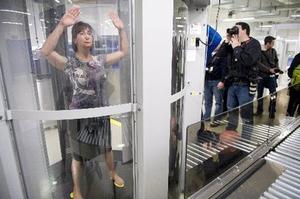Airport security is big business, and Rapiscan Systems benefits
Airport security is serious business and, increasingly, it is also big business; TSA plans to deploy as many as 1,800 full-body scanner at U.S. airports by the end of 2014; at $170,000 a scanner, this is a $300 million proposition

Scanner in use at New Jersey's Newark Liberty Airport // Source: nj.com
Airport security is serious business and, increasingly, it is also big business. One of the companies that has proven itself adept at capturing that business so far has been Rapiscan Systems, a unit of OSI Systems. Rapiscan assembles a key product at a 35-employee plant in Ocean Springs, Mississippi.
The U.S. Transportation Security Administration (TSA) plans to deploy 450 full-body scanner at U.S. airports by the end of 2010, 950 scanners by the end of 2011, and as many as 1,800 scanners by late 2014, according to the Government Accountability Office. At $170,000 a scanner, this is more than $300 million overall for what TSA calls “advanced imaging technology.”
Jeff Amy writes in GulfLive that so far, Rapiscan and New York-based L-3 Communications Corp. have been splitting those orders.
On 18 June, TSA deployed a Rapiscan machine at the Gulfport-Biloxi International Airport. It uses backscatter X-rays to find items underneath a passenger’s clothing.
Rapiscan has also sold machines to Nigeria and the United Kingdom.
“The funnel of orders we are chasing is at an all time high,” Deepak Chopra told investment analysts in April. Chopra — not the famous author and physician — is the chief executive of OSI Systems of Hawthorne, Califorinia.
Amy notes that besides body scanners, Rapiscan also makes metal detectors, X-ray machines for luggage, and other systems that scan cargo and vehicles. OSI also has a healthcare division called Spacelabs and an optoelectronic division that makes products for Rapiscan, Spacelabs, and outside firms.
In the nine months that ended 31 March, the security unit’s revenue fell 3.8 percent. Revenue rose 23 percent in the first three months of 2010, however, and operating profit more than doubled in that quarter. An analyst for investment firm Stephens Inc. projected earlier this month that security revenue would rise 23 percent by June 2011 and another 10 percent by June 2012.
Tom Schoemann, who leads Rapiscan’s Ocean Springs unit, said that the company is already assembling as many as fifty units a month in Ocean Springs, but said it could do more than that by adding a second shift. “We want to make it very clear that we have the production capacity to meet any increase in demand for this product without impacting our other customers and product lines in any shape or form,” Chopra said in January.
The glare of attention on body-scanning technology was intense that month, only weeks after Umar Farouk Abdulmutallab was arrested and accused of trying to bomb a plane traveling from Amsterdam to Detroit. Authorities said he used explosives that he smuggled through security in his underwear.
Though a few experts disputed whether the scanner would have caught the material, DHS secretary Janet Napolitano told a Senate committee in January that advanced imaging technology remains only part of an effective approach. “In and of itself, no one technology, no one process, no one intel agency is the silver bullet here,” she said. “It’s layer, layer, layer.”
Amy notes that in addition to privacy concerns relating to full-body scanners, objections have also been raised on health grounds. A group of researchers from the University of California San Francisco warned that X-rays from the Rapiscan devices in particular might pose a danger because radiation energy, though a low dose, is focused on the skin.
“There is good reason to believe that these scanners will increase the risk of cancer to children and other vulnerable populations,” the researchers wrote. “We are unanimous in believing that the potential health consequences need to be rigorously studied before these scanners are adopted.”
TSA and Rapiscan say that radiation risks are very low, though — 1,000 times smaller than a chest X-ray or 60 times less than the radiation that a human absorbs each day on Earth.
Rapiscan also cites a January statement from the American College of Radiology that says scanners do not “present significant biological effects for passengers screened.”
Amy writes that all the fuss seems to have registered little on the public. Two separate polls done in January show that three-fourths of Americans approve of the machines’ use. “I think it’s a foregone conclusion that this technology is going to be here for a long time,” Rapiscan’s Schoemann said.
